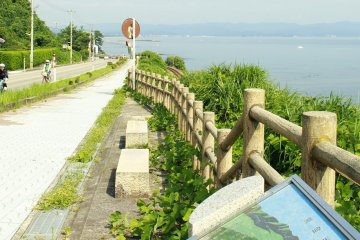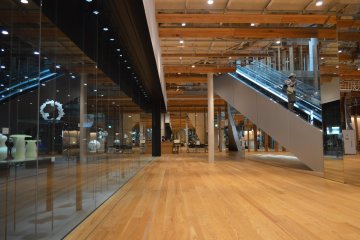Toyama Prefecture, nestled along Japan’s north-western coast with the Sea of Japan, boasts breathtaking alpine landscapes, vibrant coastlines, and rich traditions. Known for the iconic Tateyama Kurobe Alpine Route, Toyama is a gateway to scenic mountains, coastal towns, and famous seafood. This prefecture blends natural beauty with historic charm, offering unique experiences year-round.
Sightseeing spots and experiences
Kurobe Gorge Trolley Train

Kurobe Gorge, nestled in Toyama’s rugged mountains on the edge of Japan’s Northern Alps, offers a stunning journey through deep ravines, lush forests, and pristine rivers. The Kurobe Gorge Railway’s sightseeing train winds along the cliffs, showcasing breathtaking views along what is Japan’s deepest V-shaped gorge.

The railway historically served an industrial purpose to assist hydroelectric power plant construction, but now the line is open to tourists. Especially vibrant in autumn, this scenic route—which even passes some hidden hot springs—covers a 20km / 80-min journey between Unazuki Station and Keyakidaira Station. However, it should be noted that due to damage to a bridge further along the route sustained in the 2024 Noto earthquake, the current route stops at Nekomata Station (a 40-minute journey).
Access: From Toyama Station, it’s about 2 hr by local train to reach Unazuki Station. This can also be reached in 20 min from Shin-Kurobe Station, a stop along the Hokuriku Shinkansen route. (Google Map)
Tateyama Kurobe Alpine Route

Adventure enthusiasts should seek out the Tateyama Kurobe Alpine Route for its impressive path that traverses the Japanese Alps, taking in stunning landscapes along the way. The full 90-km course—nicknamed the “Roof of Japan”—connects Toyama’s Tateyama Station in the west, to Nagano prefecture’s Ogizawa in the east. The full journey sees an elevation change of 2400 meters and makes use of bus, cable car, and ropeway to help you across the mountains as you absorb alpine views over Kurobe Dam or traverse Snow Corridors in Murodo.

The strong transport infrastructure in place along the route means you don’t need to be a seasoned hiker either, making this suitable for families and casual groups, and there are things to do along the way at each stop along the route. For example, the Murodo area alone offers hiking trails in the local area during summer, while April, May and even June offer the chance to witness the famed Snow Corridors. Several accommodations and restaurants exist here too, which are ideal for those taking the route at a slower pace.

Access:
The full route can be done in one day, but it is recommended to depart early enough to allow for sufficient sightseeing at each connection. The full route is open between mid-April and November each year—confirm the exact dates on the official website.
- Starting from the western Toyama entrance of the route at Tateyama Station, it’s a 1 hr 15 min journey by tram and train from Toyama Station.
- If starting from the eastern Nagano entrance at Ogizawa, it’s about a 2-hour journey direct from Nagano Station by express bus, or a 45-minute local bus journey from JR Shinano-Omachi Station
- Here’s the full transport alpine route path, with time references (in order of west-to-east):
- Tateyama Station to Bijodaira (Tateyama Cable Car) — 7min
- Bijodaira to Murodo (Tateyama Highland Bus) — 50min
- Murodo to Daikanbo (Tateyama Tunnel Trolley Bus) — 10min
- Daikanbo to Kurobedaira (Tateyama Ropeway) — 7min
- Kurobedaira to Kurobeko (Kurobe Cable Car) — 5min
- Kurobeko to Kurobe Dam — 15min, by foot
- Kurobe Dam to Ogizawa (Kanden Tunnel Electric Bus) — 16min
Gokayama's Ainokura and Suganuma Villages

Nestled in the mountainous region of south-west Toyama, the Gokayama region—home to a cluster of picturesque villages including Ainokura and Suganuma—is renowned for its well-preserved gassho-zukuri farmhouses, characterized by their steep thatched roofs.
Along with nearby Shirakawa-go over the border in Gifu prefecture, this region is recognized as a UNESCO World Heritage site, thanks to its traditional heritage as well as historical practices, like mulberry tree cultivation and silkworm rearing.

Ainokura village is the largest of the villages in the Gokayama region, with 20 gassho-zukuri farmhouses located here. Though most of them continue to exist as private residences, several are converted making for restaurants, a museum and minshuku (for guest stays) space in the area too. Given its more remote location, it sees less visitors than other villages.
Suganuma village is home to several gassho-zukuri farmhouses, as well as minshuku, restaurants and museums shedding light on historical washi paper and saltpeter production in the region. The nearby Gokayama Gassho no Sato is a 5-min walk away and home to several relocated farmhouses, typically used for group stays and cultural activities.
Access: Ainokura is a 45-minute bus ride from Shirakawago, whereas Suganuma can be reached in 30 minutes. From the Toyama side, you can take a train to JR Jōhana Station (1hr 20min from Toyama Station) before taking an onward bus service. (Google Maps: Ainokura / Suganuma)
Toyama Glass Art Museum

The Toyama Glass Art Museum showcases an impressive collection of contemporary glass art from around the world, within a striking architectural space designed by the renowned Kengo Kuma. Located in the heart of Toyama City—a ‘Glass Art City, Toyama’—the museum features intricate glass sculptures, installations, and exhibitions.
Permanent exhibitions are housed on the fourth and sixth floors, the latter home to the Glass Art Garden—a collection of glass installations by the master of contemporary glass art, Dale Chihuly.
Historically, Toyama’s association with glass was borne out of its reputation as a traditional medicine producer. As industrialization led to increasingly liquid forms of medicine, the region evolved into a leading producer of blown glass medicine bottles to meet demand for high quality storage. Today, the region leverages its heritage as a major producer of blown glass art in Japan, making Toyama’s Glass Art Museum a must-visit destination for history, art and design enthusiasts alike.
Access: 11 min by tram from Toyama Station — alight at Nishicho Station (Google Maps)
Toyama Glass Studio

Toyama Glass Studio is a creative hub where artisans and visitors alike can experience the art of glassmaking. Offering workshops and exhibitions, the studio offers an inspiring space to witness intricate glassblowing techniques, reflecting Toyama’s dedication to contemporary glass artistry.
The studio offers both seasonal workshops and daily workshops. Choose from several daily courses, such as glass-blowing techniques or making a paper-weight. Each workshop takes about 30 minutes per person, including explanation about the process as well as design time. Finished pieces take about a week to complete before shipping to a domestic location of your choice, so please bear this in mind if traveling from overseas.

Access: Toyama Glass Studio is located just outside the Toyama Family Park area, to the west of the downtown area. It’s about a 20 min taxi ride from Toyama Station, but can also be reached via several buses. (Google Maps)
Restaurants and cafes
Black ramen @ Nishicho Taiki

Toyama Black Ramen is considered one of the prefecture’s local specialties, proudly served by many stores in the region. It is said to have been first served by Nishichō Taiki in 1947. Known for its rich, dark soy-based broth, this salty style of ramen is balanced with thick succulent noodles and topped with sliced pork, green onions and black pepper. It’s a must-try for ramen lovers, and captures the essence of the Toyama region.
Access: There are 6 branches of Taiki around the prefecture, but the easiest to visit is Toyama Station’s branch, in the Toyamarche food and souvenir store area (with its direct access gate to the Hokuriku Shinkansen station). The honten (original store) can be reached in a 12-min tram journey to the south of the station — alight at Nishicho Station. (Google Maps: station store / honten)
Shiroebi-tei

Shiroebi, or white shrimp, is a popular local dish associated with Toyama Prefecture, with this delicately-flavored delicacy sourced from nearby Toyama Bay. The Shiroebi-tei store, located at Toyama Station, is one of the most accessible places to try this local Toyama food.
They serve shiroebi in a variety of styles—including sashimi and tempura—as well as a variety of other rice bowl dishes, so you can easily find something for you. Savor the delicate flavors of this Toyama brand dish.
Access: Shiroebi-tei is located at Toyama Station, in the Toyamarche food and souvenir store area (with its direct access gate to the Hokuriku Shinkansen station). (Google Maps)
Accommodations
Unazuki Onsen, Himi Onsen-kyo, Shogawa Onsen

Toyama Prefecture is home to several renowned hot spring resort areas, like the hot spring town of Unazuki Onsen at the entrance of Kurobe Gorge. Several hot spring hotels and ryokan cluster around the Kurobe River here, and visitors can enjoy strolling around the town as well as several footbaths dotted around.

The Himi hot spring village along Toyama’s western coastline comprises 10 hot springs which offer relaxing coastal views where the Tateyama Mountain Range can be seen rising from Toyama Bay. Local specialities like Himi beef and udon as well as fresh seafood caught in Toyama Bay make this a compelling hot spring destination.
The therapeutic Shogawa Onsen area can be found in western Toyama prefecture along the banks of the Shõ River. Several resort hotels, like Sanrakuen or Yumetsuzuri, reside on the riverside here, in an area famous for its salt-grilled ayu (sweetfish).
Visiting Toyama Prefecture
Toyama Prefecture awaits, offering an inspiring mix of towering mountains, serene coastlines, and cultural richness. Whether trekking the Tateyama Kurobe Alpine Route, savoring local seafood, or exploring charming villages, Toyama promises a unique and unforgettable journey. Embrace this stunning destination and discover its natural wonders firsthand.
Access to Toyama
Toyama is easily accessible by plane, train, and bus.
Plane
Toyama’s main airport, Toyama Airport (TOY), is located south of the main downtown area of Toyama City and can be reached from the main JR Toyama Station in about 40 minutes via limousine bus or local buses. The flight from Tokyo’s Haneda Airport generally takes about 1 hour.
Train
JR Toyama Station lies on the Hokuriku Shinkansen line (connecting Tokyo to Fukui) and it takes about 2 hr 15 min to ride to Toyama from Tokyo Station via bullet train. From Osaka, Kyoto, and Nagoya Station, you can catch an express train to Tsuruga Station in Fukui Prefecture. The train ride is between one hour and one hour and 40 minutes. From Tsuruga Station, you must transfer to the Hokuriku Shinkansen for Toyama Station—approximately 1 hour 20 minutes.
Bus
Toyama has numerous highway and night buses that connect to major stations like Tokyo, Osaka, Kyoto, and Nagoya. Buses are an affordable alternative to plane and train travel but have much longer travel times.





















